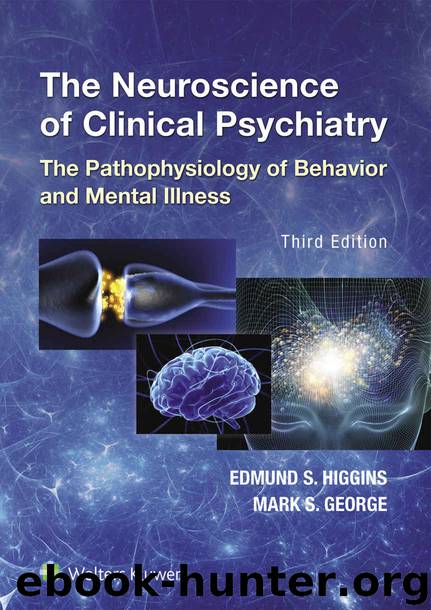Neuroscience of Clinical Psychiatry: The Pathophysiology of Behavior and Mental Illness by Edmund S. Higgins Md & Mark S. George Md

Author:Edmund S. Higgins Md & Mark S. George Md [Higgins, Edmund S. Md & George, Mark S. Md]
Language: eng
Format: epub
Tags: Science, Psychology, Philosophy
ISBN: 9781451101546
Amazon: 1451101546
Goodreads: 735909
Publisher: LWW
Published: 2007-05-18T00:00:00+00:00
Bipolar Disorder
Bipolar disorder is another condition associated with circadian dysfunction. The delay in sleep onset and reduction in sleep duration accompanying a manic episode are clear examples of disrupted circadian rhythm. Additionally, the mood stabilizer lithium is known to lengthen the circadian period, which may be one of its mechanisms of action.
Of particular interest is the predictive value of sleep disruption and mania. It is well known that a decreasing need to sleep can precede a manic episode. Wehr et al. believe that individuals with bipolar disorder are predisposed to exacerbations of the illness when sleep deprived. Because manic behavior interferes with sleep and sleep deprivation makes mania worse, a vicious downward cycle can be established. They describe a highly educated, successful individual who developed bipolar disorder in his mid-40s. Despite aggressive pharmacologic management, he cycled between depression and mania every 6 to 8 weeks. He also showed great fluctuations in his sleep–wake phases across these cycles.
The clinicians interupted the cycling by encouraging the subject to remain at bed rest in a dark room for 14 hours each night. This was later tapered to 10 hours per night. Remarkably, his mood and sleep stabilized. Periods of hyperactivity and hypoactivity were greatly reduced. The effects were still present after 1 year. It is worth noting that he remained on divalproex sodium and sertraline. The authors believe that “dark therapy” synchronized and stabilized the circadian rhythms. Subsequently a randomized controlled study showed positive results but is not an easy treatment to coordinate.
More recently a group in Norway has been studying blue-blocking glasses (also called orange-tinted glasses). This treatment is based on the finding that blue light–sensitive photoreceptors in the eye are responsible for communicating with the master clock: the SCN. Blocking blue light inhibits signals to the SCN, which creates virtual darkness in the brain, synchronizes circadian rhythms, and restores normal melatonin levels. A small randomized placebo-controlled trial found that the addition of blue-blocking glasses to usual care was significantly more effective at reducing manic symptoms than usual care and placebo.
Download
This site does not store any files on its server. We only index and link to content provided by other sites. Please contact the content providers to delete copyright contents if any and email us, we'll remove relevant links or contents immediately.
| Administration & Medicine Economics | Allied Health Professions |
| Basic Sciences | Dentistry |
| History | Medical Informatics |
| Medicine | Nursing |
| Pharmacology | Psychology |
| Research | Veterinary Medicine |
Periodization Training for Sports by Tudor Bompa(8170)
Why We Sleep: Unlocking the Power of Sleep and Dreams by Matthew Walker(6618)
Paper Towns by Green John(5088)
The Immortal Life of Henrietta Lacks by Rebecca Skloot(4525)
The Sports Rules Book by Human Kinetics(4290)
Dynamic Alignment Through Imagery by Eric Franklin(4116)
ACSM's Complete Guide to Fitness & Health by ACSM(3989)
Kaplan MCAT Organic Chemistry Review: Created for MCAT 2015 (Kaplan Test Prep) by Kaplan(3939)
Introduction to Kinesiology by Shirl J. Hoffman(3722)
Livewired by David Eagleman(3682)
The Death of the Heart by Elizabeth Bowen(3551)
The River of Consciousness by Oliver Sacks(3536)
Alchemy and Alchemists by C. J. S. Thompson(3448)
Bad Pharma by Ben Goldacre(3355)
Descartes' Error by Antonio Damasio(3229)
The Emperor of All Maladies: A Biography of Cancer by Siddhartha Mukherjee(3064)
The Gene: An Intimate History by Siddhartha Mukherjee(3047)
The Fate of Rome: Climate, Disease, and the End of an Empire (The Princeton History of the Ancient World) by Kyle Harper(3003)
Kaplan MCAT Behavioral Sciences Review: Created for MCAT 2015 (Kaplan Test Prep) by Kaplan(2936)
